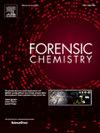Characterizing nitrocellulose by nitration degree and molecular weight: A user-friendly yet powerful forensic comparison method for smokeless powders
IF 2.6
3区 医学
Q2 CHEMISTRY, ANALYTICAL
引用次数: 0
Abstract
Smokeless powders (SPs) are commonly used as propellant for ammunition but are also used as explosive component in improvised explosive devices. Therefore, its chemical characterization is of high importance when reporting forensic explosives investigations to a court of law. While conventional analytical strategies focus on the characterization of the additives in SPs, only few methods consider the main explosive component in SP, nitrocellulose (NC).
In this study, a user-friendly analytical method was developed for characterizing NC in SPs. The method employs size-exclusion chromatography combined with ultraviolet (UV) and refractive index (RI) detection. Through the size separation, the SP additives are separated from the polymeric NC because of their lower molecular weight. The novel part of the system lies in the simultaneous measurement of the molecular-weight distribution (MWD) and the nitration degree, thus boosting the discriminating power obtained from a single analysis. The combined use of two detectors enables a highly specific analysis, because the ratio between the UV and RI signal intensities is directly correlated with the nitration degree of NC. Characterizing the nitrocellulose demonstrated high discriminating powers of 98.95 % for the MWD and 92.65 % for the nitration degree using a set of 20 SP products. Combined, all sample pairs in our sample set could be distinguished.
The proposed method is not limited to product classification that is obtained from additive profiles, and potentially offers individualization at batch level. This method provides high discriminating power while requiring little financial investment with regards to instrumentation and maintenance.

硝化度和分子量表征硝化纤维素:一种用户友好但强大的无烟粉末法医比较方法
无烟火药是常用的弹药推进剂,但也用作简易爆炸装置的爆炸成分。因此,在向法庭报告法医爆炸物调查时,其化学特性是非常重要的。传统的分析方法侧重于SP中添加剂的表征,而很少有方法考虑SP中的主要爆炸成分——硝化纤维素(NC)。在这项研究中,开发了一种用户友好的分析方法来表征SPs中的NC。该方法采用排色色谱法结合紫外(UV)和折射率(RI)检测。SP添加剂由于分子量较低,通过粒径分离,从聚合物NC中分离出来。该系统的新颖之处在于同时测量分子量分布(MWD)和硝化程度,从而提高了单次分析获得的判别能力。两种检测器的结合使用可以进行高度特异性的分析,因为UV和RI信号强度之间的比率与NC的硝化程度直接相关。用一组20个SP产品表征硝化纤维,对MWD和硝化度的识别率分别为98.95%和92.65%。综合起来,我们的样本集中的所有样本对都可以被区分。所提出的方法不限于从添加剂配置文件中获得的产品分类,并且可能在批量级别提供个性化。该方法提供了高判别能力,同时在仪器和维护方面需要很少的财务投资。
本文章由计算机程序翻译,如有差异,请以英文原文为准。
求助全文
约1分钟内获得全文
求助全文
来源期刊

Forensic Chemistry
CHEMISTRY, ANALYTICAL-
CiteScore
5.70
自引率
14.80%
发文量
65
审稿时长
46 days
期刊介绍:
Forensic Chemistry publishes high quality manuscripts focusing on the theory, research and application of any chemical science to forensic analysis. The scope of the journal includes fundamental advancements that result in a better understanding of the evidentiary significance derived from the physical and chemical analysis of materials. The scope of Forensic Chemistry will also include the application and or development of any molecular and atomic spectrochemical technique, electrochemical techniques, sensors, surface characterization techniques, mass spectrometry, nuclear magnetic resonance, chemometrics and statistics, and separation sciences (e.g. chromatography) that provide insight into the forensic analysis of materials. Evidential topics of interest to the journal include, but are not limited to, fingerprint analysis, drug analysis, ignitable liquid residue analysis, explosives detection and analysis, the characterization and comparison of trace evidence (glass, fibers, paints and polymers, tapes, soils and other materials), ink and paper analysis, gunshot residue analysis, synthetic pathways for drugs, toxicology and the analysis and chemistry associated with the components of fingermarks. The journal is particularly interested in receiving manuscripts that report advances in the forensic interpretation of chemical evidence. Technology Readiness Level: When submitting an article to Forensic Chemistry, all authors will be asked to self-assign a Technology Readiness Level (TRL) to their article. The purpose of the TRL system is to help readers understand the level of maturity of an idea or method, to help track the evolution of readiness of a given technique or method, and to help filter published articles by the expected ease of implementation in an operation setting within a crime lab.
 求助内容:
求助内容: 应助结果提醒方式:
应助结果提醒方式:


